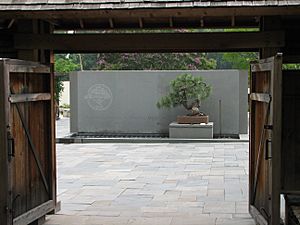National Bonsai Foundation facts for kids
The National Bonsai Foundation (NBF) is a special group that helps support the National Bonsai and Penjing Museum. The foundation works with the United States National Arboretum to teach people about the amazing arts of bonsai and penjing.
The museum is located on the large campus of the U.S. National Arboretum in Washington, D.C. Every year, more than 200,000 people come to see the incredible miniature trees.
Contents
What is the Foundation's Goal?
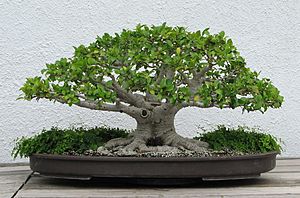
The National Bonsai Foundation is a non-profit group started in 1982. Its main job is to support the National Bonsai and Penjing Museum. It helps the museum by raising money and giving advice.
This partnership allows the museum to show off beautiful bonsai and penjing from around the world. It also helps build friendships between different cultures.
History of the Museum
In 1976, the country of Japan gave a special gift to the United States for its 200th birthday. The gift was 53 beautiful bonsai trees. These trees were carefully chosen by experts from the Nippon Bonsai Association.
When the trees arrived, volunteers and staff at the U.S. National Arboretum worked hard to care for them. In 1982, a group of bonsai experts formed the National Bonsai Foundation (NBF) to help protect and grow the collection.
Adding American Trees
In 1986, the NBF decided to build a special place to display bonsai created in North America. This new building, the John Y. Naka North American Pavilion, opened on October 1, 1990. It was named after a famous American bonsai master. The pavilion has a classroom and a display area for the North American bonsai trees.
Growing the Museum
During the 1990s, the museum grew a lot thanks to donations. A special conservatory was built in 1993 for tropical trees that need a warm home. In 1996, the Mary E. Mrose Exhibit Gallery was added for special shows.
The foundation has also published books about bonsai and viewing stones. It has hosted events, including the World Bonsai Convention in 2005, bringing together bonsai lovers from all over the globe.
The Museum's Amazing Collections
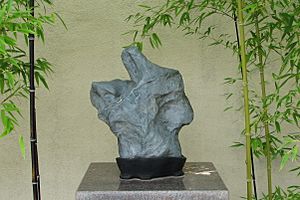
The National Bonsai and Penjing Museum has four main collections. These include trees from Japan, China, and North America, as well as a collection of special viewing stones. The museum has had several expert curators who have cared for these living works of art over the years.
Japanese Collection
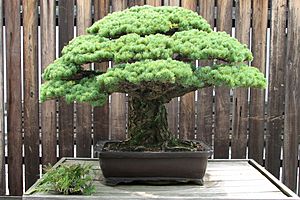
This collection began with the 53 trees that were a gift from Japan in 1976. Today, the collection has grown to 63 trees. One of the most famous trees is the Yamaki Pine. This Japanese white pine has been in training since 1625 and is a symbol of peace and strength.
You can see these trees in the Japanese Pavilion from spring to fall. In the winter, they are moved to a different pavilion to protect them from the cold.
Chinese Collection
The Chinese Collection features the art of penjing, which is very similar to bonsai. This collection is housed in the Yee-sun Wu Chinese Garden Pavilion. It was named after Dr. Yee-sun Wu, a master of penjing from Hong Kong.
In 1983, Dr. Wu helped bring penjing to the museum. He gave money to build the pavilion and also donated many of his own beautiful penjing trees.
North American Collection
The North American Collection showcases 63 bonsai trees created by artists from North America. Most of these trees are displayed in the John Y. Naka North American Pavilion.
At the entrance to the pavilion, you can see Goshin, a famous bonsai forest created by John Y. Naka. It is made of eleven juniper trees that represent his grandchildren.
Viewing Stone Collection
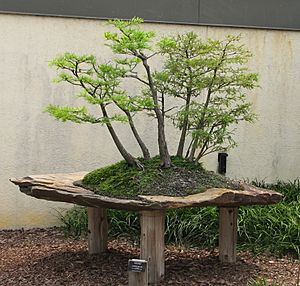
Besides trees, the museum has a world-class collection of viewing stones, also known as suiseki. Viewing stones are naturally shaped rocks that look like miniature mountains, animals, or other objects from nature.
Bonsai and viewing stones are often displayed together because they both celebrate the beauty of the natural world. The collection started with six stones from Japan and now has over 100 stones from around the world.


